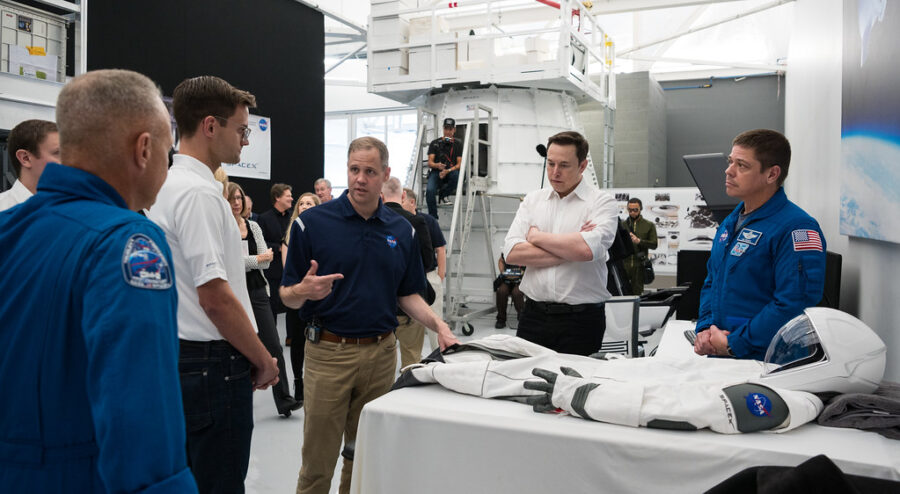Opinion: Commercial space exploration is a bad omen for the future
Photo credit: NASA/Aubrey Gemignani
SpaceX Chief Engineer Elon Musk, and others from SpaceX and NASA look at a version of a SpaceX spacesuit in Hawthorne, CA.
March 21, 2023
Within the past three years, companies have taken an increasingly large role in modern day space exploration, and while some praise them for their advances in technology or affordability, they fail to see the issues that slapping a brand onto space exploration has.
Companies have always had a place in spaceflight, some famous examples being Northrop Grumman’s work on the Apollo LEM and the plethora of corporations responsible for work on the Saturn V. Even after further lunar landings were canceled, NASA continued to work hand in hand with American industry to construct its rockets.
The main difference between NASA’s assignment of contracts during the 1960s-1970s and today is that most of the contracts NASA assigned went to already government-affiliated companies, such as Lockheed Martin and Boeing.
Today, the two companies cooperate under the name of the United Launch Alliance according to the Observer. While this has its own issues, these contracts are to companies with pre-existing contracts with the US Government, and even still it hasn’t been perfect.
Where the problems start is the way SpaceX goes about both manufacturing, launching and reporting on their launches. In 2017, CRS-13, a cargo resupply mission, was launched from Cape Canaveral and was praised by CNBC for being the first launch of a fully reusable commercial rocket. This of course ignores what SpaceX refers to as the Dragon capsule’s ‘trunk,’ as advertised by SpaceX, which burns up on reentry.
Additionally, many have praised SpaceX’s Starlink system, with many ignoring the increasing space junk problem it only serves to fuel. It’s also worth noting that issues within the staff body have increasingly become worse, with a group of SpaceX employees being fired for commenting on Elon Musk’s purchase of Twitter.
NASA has continued to give SpaceX contract after contract, including continuing to fund the Starship program, which has yet to see an actual test flight. This has given SpaceX an increasing hold on NASA, with competitors for the Human Landing System contract going as far as to sue over NASA’s failure to choose more than one lander design.
NASA’s now gone as far as creating a second round of the HLS contract for missions post Artemis-4. The COTS (Commercial Orbital Transport System) plan was what allowed SpaceX to get its foot in the door, but even then it raised criticism as reported by NPR.
Now the question we have to ask is this: Are we okay with a massive rocket with a corporate logo on the side being what returns humanity to the moon?









































Isaac • Mar 21, 2023 at 8:44 pm
Thanks or the info Counts